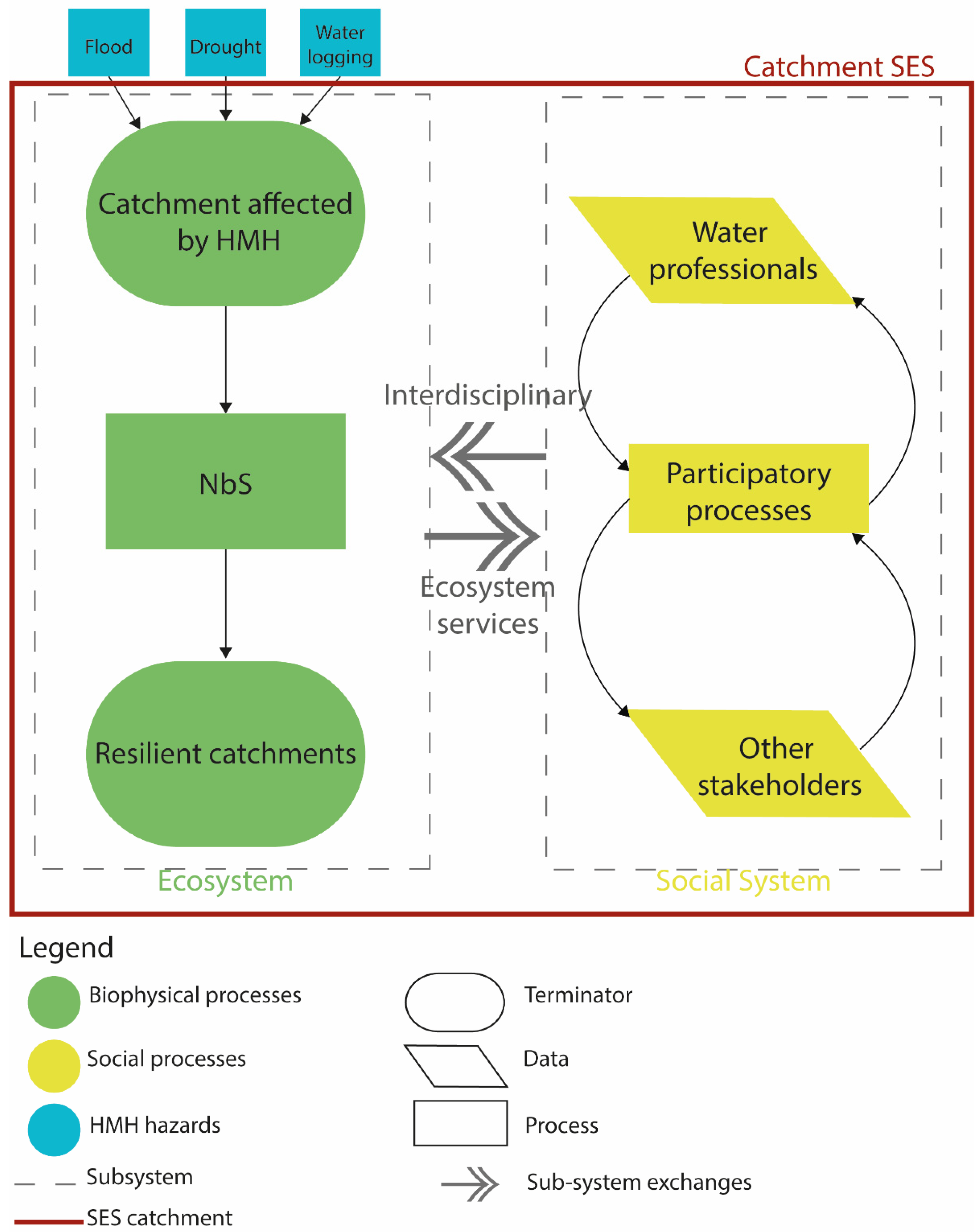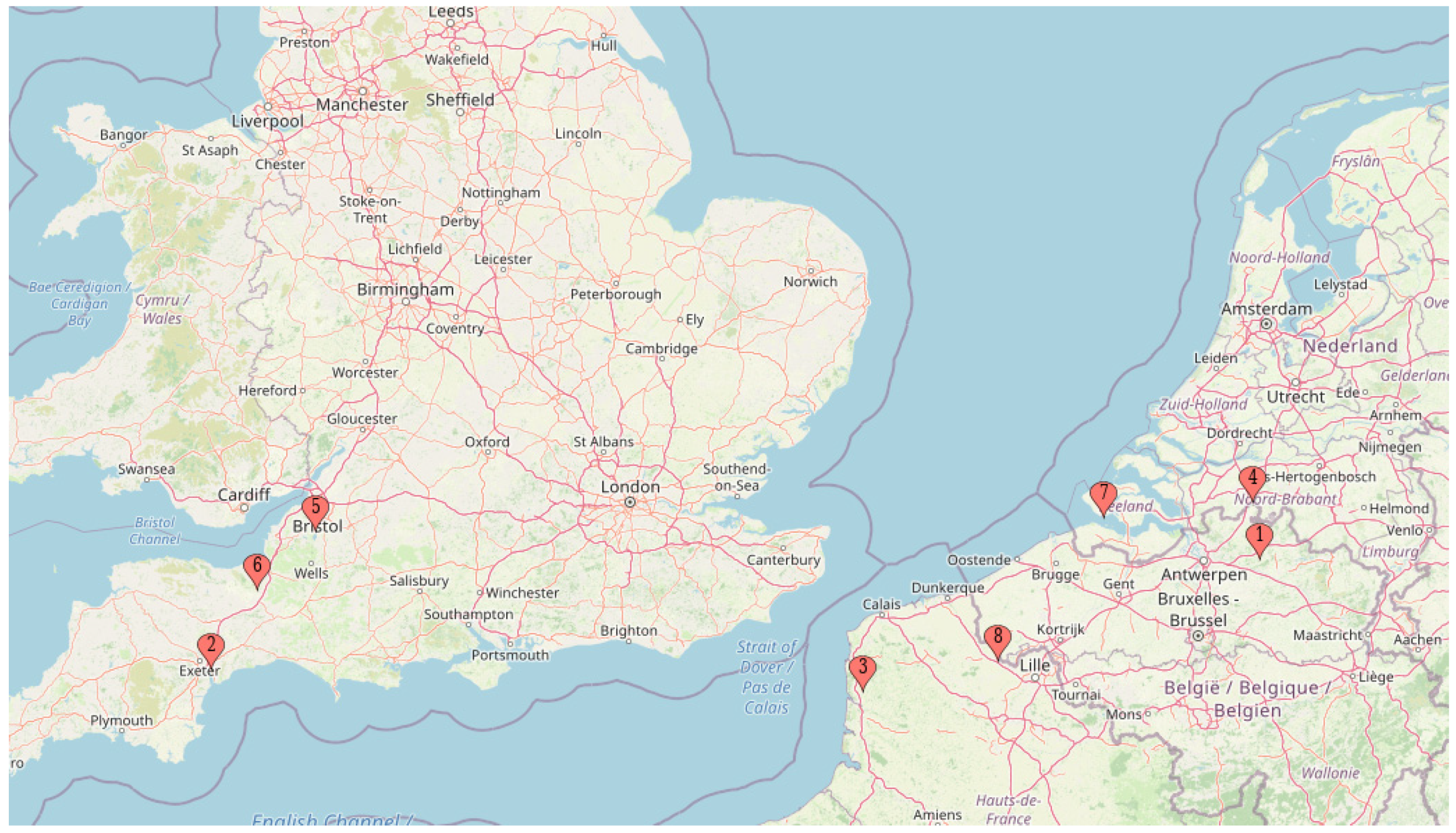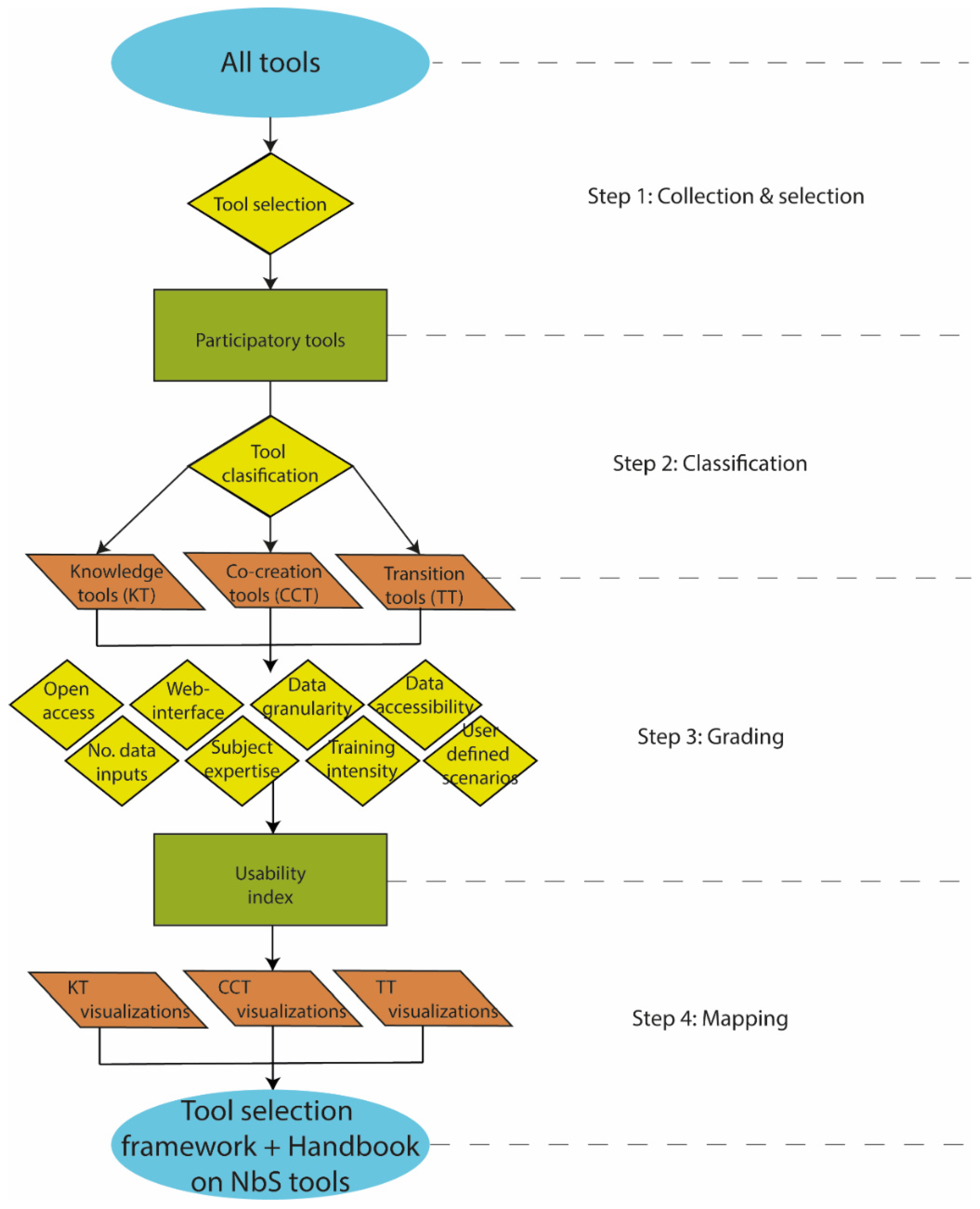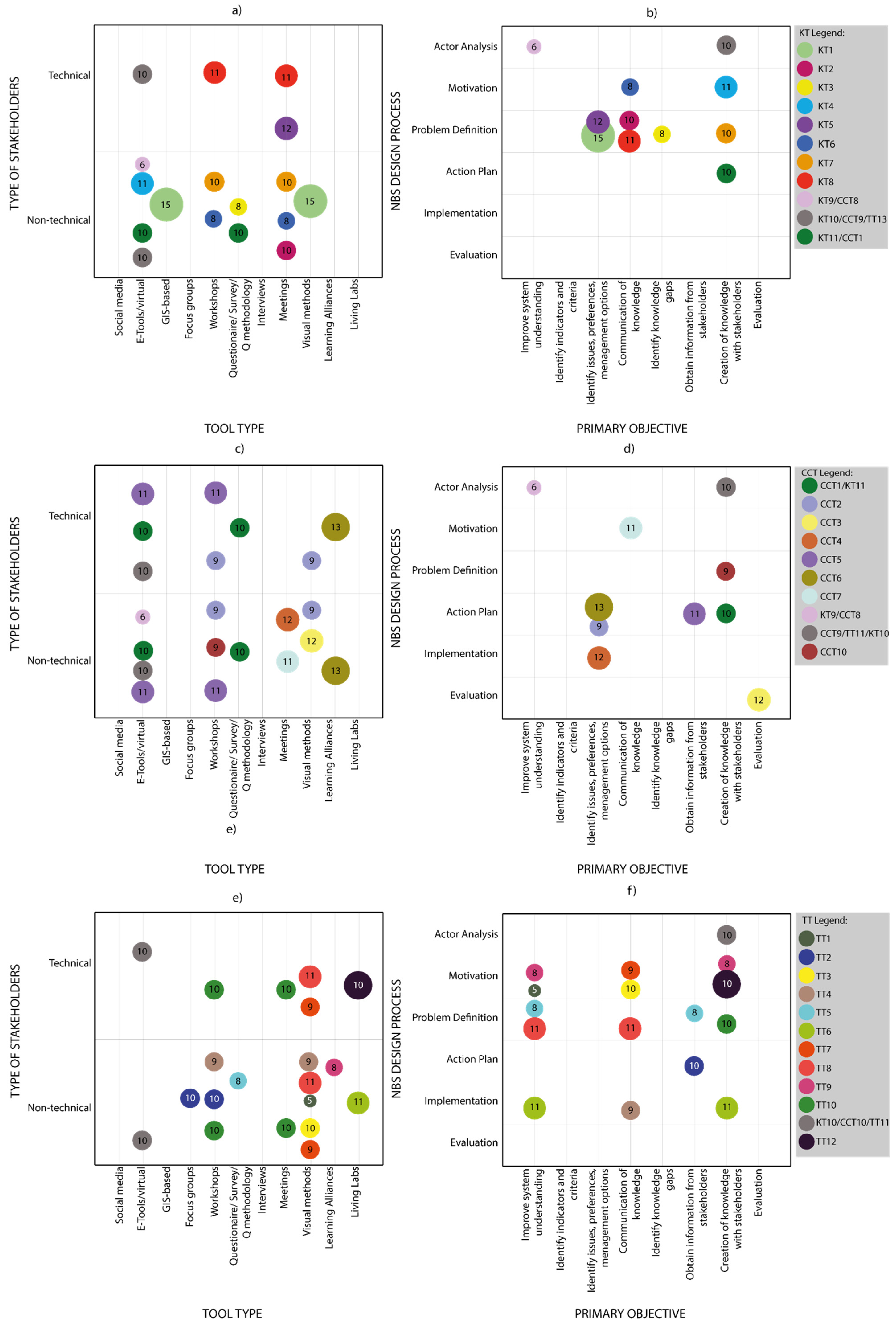Participatory Design of Nature-Based Solutions: Usability of Tools for Water Professionals
Abstract
:1. Introduction
2. Study Area: Eight Brook Catchments
2.1. Socio-Ecological System of Brook Catchments
2.2. Site Selections
3. Materials and Methods
3.1. A Stepwise Framework for Tool Selection
3.2. Step 1: Tools Collection and Selection
3.3. Step 2: Tools Classification
3.4. Step 3: Grading (of the Tools)
3.5. Step 4: Mapping
4. Results and Discussion
4.1. Framework for Selection of Participatory Tools for Designing NbS
4.2. Step 1: Collection and Selection
4.3. Step 2: Classification
4.3.1. Co-Creation Stage
4.3.2. Knowledge Stage
4.3.3. Transition Stage
4.4. Step 3: Grading
4.5. Step 4: Mapping
4.6. Tooling Insights and Trends
4.7. Case Study Comparison on Participatory Tool Selection: Pre and during Pandemic
- a website of the project where online tools were incorporated such as:
- ‘views on the climate issues survey’ (KT3) in the problem definition stage,
- ‘online ideation’ (CCT1/KT11) in the action plan stage,
- live workshops and field trips such as:
- ‘landscape planning’ (CCT2) in the action plan stage,
- ‘final design presentation’ (CCT3) in the evaluation stage, and
- ‘stakeholder forum’ (TT2) in the action plan stage.
- ‘hydrological model’ (KT1) of the catchment in the problem definition stage.
5. Conclusions
Supplementary Materials
Author Contributions
Funding
Institutional Review Board Statement
Informed Consent Statement
Data Availability Statement
Acknowledgments
Conflicts of Interest
References
- IPCC. 2021: Climate Change 2021: The Physical Science Basis. Contribution of Working Group I to the Sixth Assessment Report of the Intergovernmental Panel on Climate Change, Masson-Delmotte, V.P., Zhai, A., Pirani, S.L., Connors, C., Péan, S., Berger, N., Caud, Y., Chen, L., Goldfarb, M.I., Gomis, M., et al., Eds.; Cambridge University Press; in press.
- KNMI (2021, October 25) Klimaatsignaal’21: Hoe Staat Het Ervoor Met Het Klimaat in Nederland? 2021. Available online: https://www.knmi.nl/over-het-knmi/nieuws/klimaatsignaal21 (accessed on 20 January 2022).
- Van Dijk, A.I.; Beck, H.E.; Crosbie, R.S.; de Jeu, R.A.; Liu, Y.Y.; Podger, G.M.; Timbal, V.; Viney, N.R. The Millennium Drought in southeast Australia (2001–2009): Natural and human causes and implications for water resources, ecosystems, economy, and society. Water Resour. Res. 2013, 49, 1040–1057. [Google Scholar] [CrossRef]
- Shah, M.A.R.; Renaud, F.G.; Anderson, C.C.; Wild, A.; Domeneghetti, A.; Polderman, A.; Votsis, A.; Pulvirenti, B.; Basu, B.; Thompson, C.; et al. A review of hydro-meteorological hazard, vulnerability, and risk assessment frameworks and indicators in the context of nature-based solutions. Int. J. Disaster Risk Reduct. 2020, 50, 101728. [Google Scholar] [CrossRef]
- Maaß, A.L.; Esser, V.; Frings, R.M.; Lehmkuhl, F.; Schüttrumpf, H. Morphodynamische Entwicklung eines Renaturierten Gewässers am Beispiel der Neuen Inde. In Wasser, Energie und Umwelt; Springer Vieweg: Wiesbaden, Germany, 2022; pp. 345–356. [Google Scholar]
- De Roo, A.P.J.; Wesseling, C.G.; Ritsema, C.J. LISEM: A single-event physically-based hydrological and soil erosion model for drainage basins. I: Theory, input and output. Hydrol. Processes 1996, 10, 1107–1117. [Google Scholar] [CrossRef]
- Redman, C.; Grove, M.J.; Kuby, L. Integrating Social Science into the Long Term Ecological Research (LTER) Network: Social Dimensions of Ecological Change and Ecological Dimensions of Social Change. Ecosystems 2004, 7, 161–171. [Google Scholar] [CrossRef]
- Folke, C. Resilience: The emergence of a perspective for social-ecological systems analyses. Glob. Environ. Chang. 2006, 16, 253–267. [Google Scholar] [CrossRef]
- McGinnis, M.D.; Ostrom, E. Social-ecological system framework: Initial changes and continuing challenges. Ecol. Soc. 2014, 19, 30. [Google Scholar] [CrossRef] [Green Version]
- Cohen-Shacham, E.; Walters, G.; Janzen, C.; Maginnis, S. Nature-Based Solutions to Address Global Societal Challenges; IUCN: Gland, Switzerland, 2016; Volume 97, pp. 2016–2036. [Google Scholar]
- Ferreira, V.; Barreira, A.P.; Loures, L.; Antunes, D.; Panagopoulos, T. Stakeholders’ engagement on nature-based solutions: A systematic literature review. Sustainability 2020, 12, 640. [Google Scholar] [CrossRef] [Green Version]
- Pechlivanidis, I.G.; Arheimer, B.; Donnelly, C. Analysis of hydrological extremes at different hydro-climatic regimes under present and future conditions. Clim. Chang. 2017, 141, 467–481. [Google Scholar] [CrossRef] [Green Version]
- Huntjens, P.; Pahl-Wostl, C.; Grin, J. Climate change adaptation in European river basins. Reg. Environ. Chang. 2010, 10, 263–284. [Google Scholar] [CrossRef] [Green Version]
- Seddon, N.; Chausson, A.; Berry, P.; Girardin, C.A.; Smith, A.; Turner, B. Understanding the value and limits of nature-based solutions to climate change and other global challenges. Philos. Trans. R. Soc. B 2020, 375, 20190120. [Google Scholar] [CrossRef] [PubMed] [Green Version]
- McEvoy, S.; van de Ven, F.H.; Blind, M.W.; Slinger, J.H. Planning support tools and their effects in participatory urban adaptation workshops. J. Environ. Manag. 2018, 207, 319–333. [Google Scholar] [CrossRef] [PubMed]
- Salter, J.; Robinson, J.; Wiek, A. Participatory methods of integrated assessment—A review. WIREs Clim. Chang. 2010, 1, 697–717. [Google Scholar] [CrossRef]
- Hassenforder, E.; Smajgl, A.; Ward, J. Towards understanding participatory processes: Framework, application and results. J. Environ. Manag. 2015, 157, 84–95. [Google Scholar] [CrossRef] [PubMed] [Green Version]
- DeLosRíos-White, M.I.; Roebeling, P.; Valente, S.; Vaittinen, I. Mapping the life cycle co-creation process of nature-based solutions for urban climate change adaptation. Resources 2020, 9, 39. [Google Scholar] [CrossRef] [Green Version]
- Kumar, P.; Debele, S.E.; Sahani, J.; Aragão, L.; Barisani, F.; Basu, B.; Bucchignani, E.; Charizopoulos, N.; Di Sabatino, S.; Domeneghetti, A.; et al. Towards an operationalisation of nature-based solutions for natural hazards. Sci. Total Environ. 2020, 731, 138855. [Google Scholar] [CrossRef] [PubMed]
- Nesshöver, C.; Assmuth, T.; Irvine, K.N.; Rusch, G.M.; Waylen, K.A.; Delbaere, B.; Krauze, K. The science, policy and practice of nature-based solutions: An interdisciplinary perspective. Sci. Total Environ. 2017, 579, 1215–1227. [Google Scholar] [CrossRef]
- Alves, A.; Gómez, J.P.; Vojinovic, Z.; Sanchez, A.; Weesakul, S. Combining co-benefits and stakeholders’ perceptions into green infrastructure selection for flood risk reduction. Environments 2018, 5, 29. [Google Scholar] [CrossRef] [Green Version]
- Voskamp, I.M.; de Luca, C.; Polo-Ballinas, M.B.; Hulsman, H.; Brolsma, R. Nature-Based Solutions Tools for Planning Urban Climate Adaptation: State of the Art. Sustainability 2021, 13, 6381. [Google Scholar] [CrossRef]
- Van Asselt, M.; Rijkens-Klomp, N. A look in the mirror: Reflection on participation in integrated assessment from a methodological perspective. Glob. Environ. Chang. 2002, 12, 167–184. [Google Scholar] [CrossRef]
- Jones, N.A.; Perez, P.; Measham, T.G.; Kelly, G.J.; d’Aquino, P.; Daniell, K.A.; Dray, A.; Ferrand, N. Evaluating participatory modeling: Developing a framework for cross-case analysis. Environ. Manag. 2009, 44, 1180e1195. [Google Scholar] [CrossRef]
- Rowe, G. Evaluating public-participation exercises: A research agenda. Sci. Technol. Hum. Val. 2004, 29, 512e556. [Google Scholar] [CrossRef]
- Thissen, W.A.H.; Twaalfhoven, P.G.J. Towards a conceptual structure for evaluating policy analytic activities. Eur. J. Oper. Res. 2001, 129, 627–649. [Google Scholar] [CrossRef]
- Pahl-Wostl, C. Requirements for Adaptive Water Management. In Adaptive and Integrated Water Management; Springer: Berlin/Heidelberg, Germany, 2008; pp. 1–22. [Google Scholar]
- Reed, M.S.; Graves, A.; Dandy, N.; Posthumus, H.; Hubacek, K.; Morris, J.; Prell, C.; Quinn, C.H.; Stringer, L.C. Who’s in and why? A typology of stakeholder analysis methods for natural resource management. J. Environ. Manag. 2009, 90, 1933–1949. [Google Scholar] [CrossRef] [PubMed]
- Hund, G.; Engel-Cox, J.A.; Fowler, K.M. A Communications Guide for Sustainable Development: How Interested Parties Become Partners (No. PNWD-SA-6494); Pacific Northwest National Lab. (PNNL): Richland, WA, USA, 2004.
- Isenmann, R.; Kim, K.C. Interactive sustainability reporting. Developing Clear Target Group Tailoring and Stimulating Stakeholder Dialogue. In Sustainability Accounting and Reporting; Springer: Dordrecht, The Netherlands, 2006; pp. 533–555. [Google Scholar]
- Voinov, A.; Gaddis, E.B. Values in Participatory Modeling: Theory and Practice. In Environmental Modeling with Stakeholders; Springer: Cham, Switzerland, 2017; pp. 47–63. [Google Scholar]
- Albert, C.; Brillinger, M.; Guerrero, P.; Gottwald, S.; Henze, J.; Schmidt, S.; Ott, E.; Schröter, B. Planning nature-based solutions: Principles, steps, and insights. Ambio 2021, 50, 1446–1461. [Google Scholar] [CrossRef] [PubMed]
- Arnstein, S.R. A ladder of citizen participation. J. Am. Inst. Plan. 1969, 35, 216–224. [Google Scholar] [CrossRef] [Green Version]
- Nelimarkka, M.; Nonnecke, B.; Krishnan, S.; Aitumurto, T.; Catterson, D.; Crittenden, C.; Garland, C.; Gregory, C.; Huang, C.-C.; Newsom, G.; et al. Comparing Three Online Civic Engagement Platforms Using the Spectrum of Public Participation; Center for Information Technology Research in the Interest of Society (CITRIS): Berkeley, CA, USA, 2014. [Google Scholar]
- Beierle, T.C.; Cayford, J. Democracy in Practice: Public Participation in Environmental Decisions; Resources for the Future Press: Washington, DC, USA, 2002. [Google Scholar]
- Beierle, T.C.; Konisky, D.M. Values, conflict, and trust in participatory environmental planning. J. Policy Anal. Manag. 2000, 19, 587–602. [Google Scholar] [CrossRef]
- International Association of Public Participation [IAP2]. IAP2 Spectrum of Public Participation. 2007. Available online: http://c.ymcdn.com/sites/www.iap2.org/resource/resmgr/imported/IAP2%20Spectrum_vertical.pdf (accessed on 5 March 2022).
- Soegaard, M. Usability: A Part of the User Experience. Interaction Design Foundation. 2018. Available online: https://www.interaction-design.org/literature/article/usability-a-part-of-the-user-experience (accessed on 9 March 2022).
- Brooke, J. Sus: A “Quick and Dirty’usability. In Usability Evaluation in Industry; CRC Press: Boca Raton, FL, USA, 1996; Volume 189. [Google Scholar]
- Dargin, J.; Daher, B.; Mohtar, R.H. Complexity versus simplicity in water energy food nexus (WEF) assessment tools. Sci. Total Environ. 2019, 650, 1566–1575. [Google Scholar] [CrossRef]
- UNECE. Reconciling Resource Uses in Transboundary Basins: Assessment of the Water-Food-Energy-Ecosystems Nexus. 2015. Available online: http://www.unece.org/env/water/nexus.html (accessed on 28 April 2022).
- IRENA. Renewable Energy in the Water, Energy, & Food Nexus. 2015. Available online: http://www.irena.org/documentdownloads/publications/irena_water_energy_food_nexus_2015.pdf (accessed on 10 March 2018).
- FAO. Walking the Nexus Talk: In the Context of Sustainable Energy for All Initiative. 2014. Available online: http://www.fao.org/3/a-i3959e.pdf (accessed on 28 April 2022).
- Kaddoura, S.; El Khatib, S. Review ofwater-energy-food Nexus tools to improve the Nexus modelling approach for integrated policy making. Environ. Sci. Pol. 2017, 77, 114–121. [Google Scholar] [CrossRef]
- Fortmann-Roe, S. Insight Maker: A general-purpose tool for web-based modeling & simulation. Simul. Model. Pract. Theory 2014, 47, 28–45. [Google Scholar]
- McCarl, B.A.; Yang, Y.; Schwabe, K.; Engel, B.A.; Mondal, A.H.; Ringler, C.; Pistikopoulos, E.N. Model use in WEF nexus analysis: A review of issues. Curr. Sustain. Renew. Energy Rep. 2017, 4, 144–152. [Google Scholar] [CrossRef]
- Mccormick, K.; Kiss, B. Taking Action for Urban Nature: Innovation Pathways Directory. 2019. Available online: https://naturvation.eu/sites/default/files/result/files/innovation_pathways_directory_0.pdf (accessed on 15 December 2021).
- Rock, J.; McGuire, M.; Rogers, A. Multidisciplinary perspectives on co-creation. Sci. Commun. 2018, 40, 541–552. [Google Scholar] [CrossRef]
- Loorbach, D. Transition management for sustainable development: A prescriptive, complexity-based governance framework. Governance 2010, 23, 161–183. [Google Scholar] [CrossRef]
- Ruckelshaus, M.; McKenzie, E.; Tallis, H.; Guerry, A.; Daily, G.; Kareiva, P.; Polasky, S.; Ricketts, T.; Bhagabati, N.; Wood, S.A.; et al. Notes from the field: Lessons learned from using ecosystem service approaches to inform real-world decisions. Ecol. Econ. 2015, 115, 11–21. [Google Scholar] [CrossRef] [Green Version]
- Flood, S.; O’Higgins, T.G.; Lago, M. The Promise and Pitfalls of Ecosystem Services Classification and Valuation. In Ecosystem-Based Management, Ecosystem Services and Aquatic Biodiversity; Springer: Cham, Switzerland, 2020; pp. 87–103. [Google Scholar]
- Delacámara, G.; O’Higgins, T.G.; Lago, M.; Langhans, S. Ecosystem-Based Management: Moving from Concept to Practice. In Ecosystem-Based Management, Ecosystem Services and Aquatic Biodiversity; Springer: Cham, Switzerland, 2020; pp. 39–60. [Google Scholar]




| No. | Catchments | Country | Key Characteristics |
|---|---|---|---|
| 1 | Laakbeek | Belgium | Small brook passes through the semi-urban village with flooding history. Not much space for adaptation measures. |
| 2 | The Culm | The United Kingdom | Brook passes a new ‘green’ development area and main railway. Flooding is the main HMH causing deterioration in water quality. |
| 3 | Liane | France | Brook passes a rural area with urbanized banks causing flooding and soil erosion. |
| 4 | Aa of Weerijs | The Netherlands | Brook passes a rural area with a high density of tree nurseries for export. Main HMH is drought due to high water demand and flooding in moments of peak flows. |
| 5 | Porlock Vale | The United Kingdom | Brook passes a steep valley, creating a high risk of flooding in several villages. |
| 6 | Somerset Levels and Moors | The United Kingdom | Flooding at lower reaches in several villages. |
| 7 | Vlissingen | The Netherlands | Channelized brooks pass through the new ‘green’ development area. Flooding is the main HMH. |
| 8 | West Flanders | Belgium | Brook passes between two villages and has a history of flooding. |
| Question | Type | Criteria | |
|---|---|---|---|
| Catchments | MC | - | |
| Communication type | MC | Ad hoc, One-way, Two-way, stakeholder engagement, participatory decision making [29,30] | |
| Type of stakeholders | MC | Non-technical stakeholders (farmers, landowners, local communities; Non-agricultural businesses); Technical stakeholders (Educational and research institutions; NGO’s; Governments; Chamber of Agriculture) | |
| Description of tool | OQ | Used to classify tools as: Knowledge Tool (KTx), Transition Tool (TTx), Co-Creation Tool (CCTx) | |
| Primary Objective | MC | Improve system understanding; Identify indicators and criteria; Identify issues, preferences, management options; Communication of knowledge; Identify knowledge gaps; Obtain information from stakeholders; Creation of knowledge with stakeholder; Evaluation (adapted from [17]) | |
| NbS Design Process Stages | MC | Actor analysis; Motivation; Problem Definition; Project Definition; Action Plan; Implementation; Evaluation (adapted from [31] and [32]) | |
| Other Stages | MC | Actor analysis; Motivation; Problem Definition; Project Definition; Action Plan; Implementation; Evaluation (adapted from [31] and [32]) | |
| Level of participation | /Informing, consulting, involving, collaborating, empowering (adapted from [33,34]) | ||
| Strengths (from practitioner’s perspective) | OQ | - | |
| Weaknesses (from practitioner’s perspective) | OQ | - | |
| Practical Considerations | Time | MC | Low (few days); Medium (few weeks); High (few months) |
| Budget | MC | Low (<100 euros); Medium (<1000 euros); High (>1000 euros) | |
| No. participants | MC | Small (<20); Medium (<100); Big (>100) | |
| No. | Criteria | Score | Score Description | Justification |
|---|---|---|---|---|
| 1 | Open Access | 0 | Yes | Cost is an important consideration in defining the usability tools [45] hence the need for utilizing open access tools. |
| 1 | No | |||
| 2 | Web Interface | 0 | Yes | Tools with web interfaces reach larger and broader audiences which would translate to increasing the potential to discuss more outcomes and enhanced understanding of menagement measures such as NbS [44,45] |
| 1 | No | |||
| 3 | Data Granularity | 1 | High level; national level data | Data granularity refers to the extend of detali in a specific data point [40]. More granular data sllows more thorought system{s} modelling however it can be hard to find in open source environments [46]. |
| 2 | General data with sector specific information | |||
| 3 | Localized sector data and localized technical data | |||
| 4 | Data Accessibility | 1 | Data available for most developed and developing countries | Data acessibility is an ongoing challeng specifically for accurate design of NbS. Acessibility is always connected to the granularity – hardly accessible data points are more likely to be detailed and difficult to measure. |
| 2 | Data is hardly accessible for developing countries | |||
| 3 | Difficult to access data, derivation might require modelling tools | |||
| 5 | Number of Data Inputs | 1 | 0–15 | Data inputs entail how many inputs a tool requires for the design of NbS. |
| 2 | 16–32 | |||
| 3 | 33+ | |||
| 6 | Needed Subject Expertise | 1 | Expertise not needed | The expertise needed for the users to be able to actively participate/use the specific tool. |
| 2 | Needs an understanding of general subject matter | |||
| 3 | Expertise and high skill needed | |||
| 7 | Training Intensity | 1 | 1 day | Trainings come with additional costs, time and resources. They can include online tutorials, independent instructions, in-person trainings etc. |
| 2 | 2–3 days | |||
| 3 | 1 week | |||
| 8 | User-Defined Scenarios | 1 | Yes | User-defined scenarios give added value for the process of designing NbS however they add to the complexity of the tool. |
| 0 | No/N-A |
| Participatory Tool—title | KT | CCT | TT | Code |
|---|---|---|---|---|
| Hydrological model | ✓ | KT1 | ||
| Face to face field visits | ✓ | KT2 | ||
| ‘Views on the climate issues’ survey | ✓ | KT3 | ||
| Knowledge transfer website and newsletter | ✓ | KT4 | ||
| Public technical stakeholders’ meetings | ✓ | KT5 | ||
| Public citizen meetings (Online) | ✓ | KT6 | ||
| Public citizen meetings (Physical) | ✓ | KT7 | ||
| Knowledge co-creation workshop | ✓ | KT8 | ||
| The walking app | ✓ | ✓ | * KT9/CCT8 | |
| Online ideation | ✓ | ✓ | * KT11/CCT1 | |
| Adaptation Pathways tool | ✓ | ✓ | ✓ | * CCT9/TT11/KT10 |
| Landscape planning | ✓ | CCT2 | ||
| Final design presentation | ✓ | CCT3 | ||
| Individual farm visits | ✓ | CCT4 | ||
| Digital collaboration tools | ✓ | CCT5 | ||
| The Forum | ✓ | CCT6 | ||
| Film Nights | ✓ | CCT7 | ||
| Flyer for planned future events | ✓ | TT1 | ||
| Stakeholder forum/Round table | ✓ | TT2 | ||
| Permanent information plaques and project area accessibility | ✓ | TT3 | ||
| Educational trainings and materials for primary schools | ✓ | TT4 | ||
| Maptionnaire | ✓ | TT5 | ||
| Citizen Science | ✓ | TT6 | ||
| Storymaps | ✓ | TT7 | ||
| Travel guide to climate robust river landscapes | ✓ | TT8 | ||
| Design thinking—Embassy of Water | ✓ | TT9 | ||
| Citizen meetings | ✓ | TT10 | ||
| Landscape Fund | ✓ | TT12 |
Publisher’s Note: MDPI stays neutral with regard to jurisdictional claims in published maps and institutional affiliations. |
© 2022 by the authors. Licensee MDPI, Basel, Switzerland. This article is an open access article distributed under the terms and conditions of the Creative Commons Attribution (CC BY) license (https://creativecommons.org/licenses/by/4.0/).
Share and Cite
Bogatinoska, B.; Lansu, A.; Hugé, J.; Dekker, S.C. Participatory Design of Nature-Based Solutions: Usability of Tools for Water Professionals. Sustainability 2022, 14, 5562. https://doi.org/10.3390/su14095562
Bogatinoska B, Lansu A, Hugé J, Dekker SC. Participatory Design of Nature-Based Solutions: Usability of Tools for Water Professionals. Sustainability. 2022; 14(9):5562. https://doi.org/10.3390/su14095562
Chicago/Turabian StyleBogatinoska, Borjana, Angelique Lansu, Jean Hugé, and Stefan C. Dekker. 2022. "Participatory Design of Nature-Based Solutions: Usability of Tools for Water Professionals" Sustainability 14, no. 9: 5562. https://doi.org/10.3390/su14095562
APA StyleBogatinoska, B., Lansu, A., Hugé, J., & Dekker, S. C. (2022). Participatory Design of Nature-Based Solutions: Usability of Tools for Water Professionals. Sustainability, 14(9), 5562. https://doi.org/10.3390/su14095562








